|
Traditional Poster Session
Spectroscopy & Non-Proton MR |
Monday, 18 June 2018
Traditional PosterSpectroscopy & Non-Proton MR
1271 -1304 MRS/MRSI Aquisition
1305 -1335 MRS/MRSI Reconstruction & Quantification
1336 -1345 Spectroscopy: NMR & Other
1346 -1360 MRS Human Applications
1361 -1368 MRS Animal Studies |
| |
MRS/MRSI Aquisition
Traditional Poster
Spectroscopy & Non-Proton MR
Monday, 18 June 2018
| Exhibition Hall 1271-1304 |
08:15 - 10:15 |
|
1271.
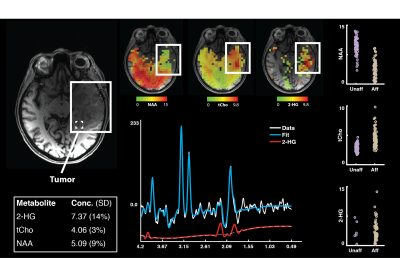 |
Metabolite cycled density-weighted concentric rings k-space trajectory (DW-CRT) enables 1H magnetic resonance spectroscopic imaging at 3 Tesla in a clinically feasible timeframe
Adam Steel, Mark Chiew, Peter Jezzard, Natalie Voets, Puneet Plaha, M. Thomas, Charlotte Stagg, Uzay Emir
In this study, we demonstrate that a metabolite-cycled semi-LASER pulse localization with density-weighted concentric rings trajectory (DW-CRT) enables high-resolution MRSI to be acquired at 3 Tesla within a clinically feasible acquisition time. High-resolution (5 x 5 x 10 mm3) DW-CRT feasibility at 3T was assessed in 6 healthy volunteers. Subsequently, the clinical utility of this approach was demonstrated by mapping the presence of 2-HG in a patient with a grade III oligodendroglioma tumor.
|
|
1272.
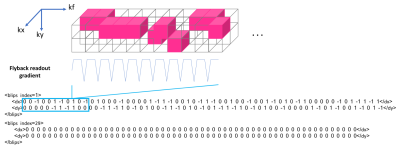 |
Standardized Parameterization of Echo-Planar Compressed Sensing MRSI Acquisition and Reconstruction
Jason Crane, Marram Olson, Yan Li, Maryam Vareth, Hsin-Yu Chen, Zihan Zhu, Sukumar Subramaniam, Peder Larson, Duan Xu, Daniel Vigneron, Sarah Nelson
Advanced MRSI acquisition strategies can be complex to implement and require customized reconstruction software, typically designed for a specific raw file format and that relies upon a priori knowledge of the specific implementation of the pulse sequence being applied. The ISMRMRD format1 has begun to address standardization in describing data acquisition parameters for different types of imaging data, but further development is needed. Here we build on this strategy by demonstrating XML encoding of parameters that describe flyback echo-planar, compressed sensing MRSI acquisitions being implemented on scanners from multiple vendors at UCSF that can be supported with generalized reconstruction software.
|
|
1273.
 |
SNR and PSF Simulations for k-t Trajectories in MRSI: CSI, EPSI, Rosettes, and Concentric Rings
Amir Seginer, Assaf Tal
We compare, using numeric simulations, the point spread functions (PSF) and the SNR of different trajectories in k-t space for magnetic resonance spectral imaging (MRSI). This is a first step towards evaluating the trajectory of choice while balancing SNR efficiency, scan time, and localization of signal (resolution vs. bleed).
|
|
1274.
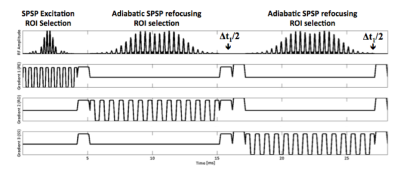 |
JSASSI: A B1 Insensitive Technique for J-Resolved 2D Magnetic Resonance Spectroscopy at 7T
Judy Alper, Rebecca Feldman, Francesco Padormo, Priti Balchandani, Gaurav Verma
Magnetic resonance spectroscopy (MRS) can be used to investigate metabolite concentration changes correlated to neurological and psychiatric diseases. Improved spectral resolution and metabolite quantification in these disorders would add to our understanding of neurodegenerative diseases. JSASSI is a novel technique for localized two-dimensional (2D) MRS, based in part on the JPRESS spectroscopic sequence while implementing pulses from the SASSI sequence. An incrementing Δt1 time delay is introduced for resolving J-coupled metabolites from overlapping resonances. JSASSI was applied in phantoms and in vivo. Metabolite peaks for NAA, Glx, Cr and others were clearly identified using JSASSI. Unambiguous detection and resolution of J-coupled metabolites could facilitate reliable quantification of metabolites such as GABA, with potential applications in characterization and treatment monitoring in psychiatric disorders.
|
|
1275.
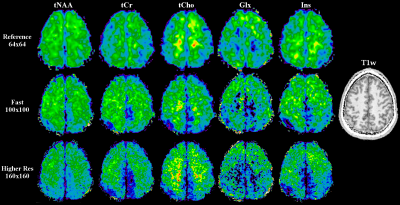 |
Optimisations for ultra-high resolution MRSI of the brain at 7 T: Towards even higher resolutions and faster measurements
Gilbert Hangel, Bernhard Strasser, Michal Povazan, Eva Heckovį, Stephan Gruber, Philipp Moser, Lukas Hingerl, Siegfried Trattnig, Wolfgang Bogner
Recently, ultra-high resolution (UHR-) MRSI of the brain at 7 T was successfully demonstrated, allowing metabolic mapping at near-anatomical resolution. With this work, we propose further optimised sequences, one for shorter measurement times of under 5 min and one for even higher in-plane resolutions down to 12 µL, which will allow a more flexible application of UHR_MRSI, and show their possibilities and limitations. Furthermore, the effects of slice thickness for UHR-MRSI were investigated with a second set of measurements.
|
|
1276.
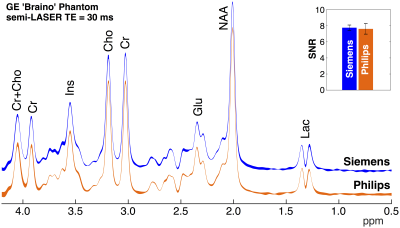 |
Cross-vendor standardization of a 3 T MRS protocol with semi-LASER
Adam Berrington, Dinesh Deelchand, James Joers, Michal Považan, Michael Schär, Joseph Gillen, Peter Barker, Gülin Öz
Acceptance of 1H-MRS for clinical use is hindered by variability in methodology across platforms. Cross-vendor standardization is thus desirable for large-scale studies to be conducted. Here, we standardize a semi-LASER scheme (TE=30 ms) with identical pulses, inter-pulse durations and acquisition protocol in phantom and healthy volunteers on Philips and Siemens 3 T systems. The implemented method resulted in high quality spectra with matched SNR, linewidth and spectral patterns in phantom and similar estimated metabolite concentrationsin vivo: between-subject CVs for NAA were (2.6-11.0)% and (3.3-10.2)% for Philips and Siemens, respectively. This method highlights the potential for pooling data across multiple sites.
|
|
1277.
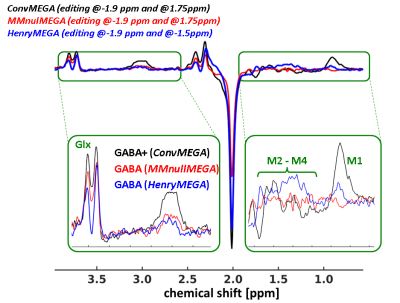 |
Intrinsic inversion recovery-based macromolecular nulling in MEGA-PRESS 1H-MR brain spectra
Alexander Gussew, Andreas Masek, Martin Krämer, Jürgen Reichenbach
The reliability of 1H-MRS MEGA-PRESS measurements of inhibitory neurotransmitter GABA in the human brain typically suffers from macromolecular (MM) contaminations of GABA resonances. In this work, we present a novel MM suppression approach, which relies on adiabatic inversion of the longitudinal magnetization of both metabolites and MMs prior to playing out the MEGA-PRESS editing scheme, which is applied after an inversion time delay (TI) corresponding to the zero-crossing of MM magnetization. As demonstrated in healthy subjects, this new approach ensures appropriate MM suppression and provides additional GABA signal gain compared to the commonly applied approach with symmetrical MM editing.
|
|
1278.
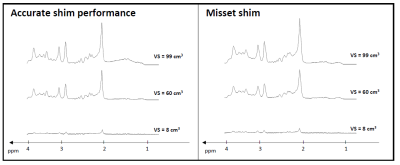 |
What is the optimal ROI size for single voxel MRS in global brain pathology?
Maike Hoefemann, Victor Adalid, Roland Kreis
The purpose of this study was to investigate optimal voxel size (VS) as a compromise between increasing SNR and decreasing linewidth under the side-constraint of minimal artifact levels and to investigate potential benefits from considering signals from single coil elements separately. Eight different VS were evaluated; hinting at optimal VS of 60 cm³ and indicating that lineshape information from unsuppressed water should be included in the fitting process. Differences in single coil elements show substantial impacts on spectral quality, indicating that individual processing and exclusion of certain channels is superior to the standard procedure of an indiscriminate weighted sum.
|
|
1279.
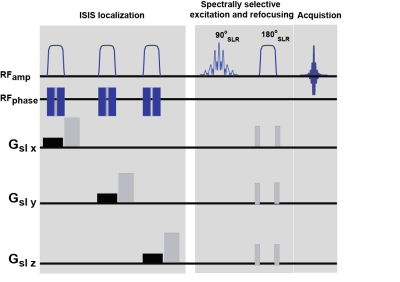 |
ISIS based Relaxation Enhanced MR spectroscopy (iRE-MRS) for downfield spectroscopy at short echo times
Sonia Goncalves, Noam Shemesh
MRS is a versatile technique that allows for the non-invasive in-vivo exploration of tissue metabolism. In most MRS pulse sequences based on broadband excitation, the acquisition is preceded by water saturation pulses that suppress the water bulk signal and implicitly also exchangeable protons downfield of water. We introduce a new method for short-TE downfield MRS and show that it detects multiple peaks in-vivo that extend beyond 9 ppm.
|
|
1280.
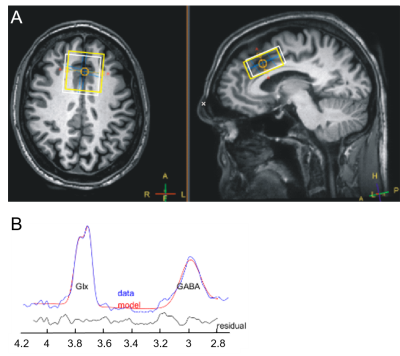 |
Repeatability and reproducibility of GABA quantification using MEGA-PRESS in anterior cingulate cortex as a biomarker for depression
Daniel Alamidi, Jan Weis, Christine Nabuurs, Mats Fredrikson, Andreas Frick, Fredrik Ahs, Jakub Kraus, Jonas Persson, Maarten Versluis
Proton MRS of the anterior cingulate cortex (ACC) is an attractive biomarker as it provides non-invasive methods to quantify GABA levels that are linked with several psychiatric disorders. This study validates a MEGA-PRESS sequence that combines phase cycling with real time frequency drift correction to measure GABA spectra in phantom and human brain. The GABA levels of the ACC were repeatable and reproducible at two different scanning sites. Consequently, the technique is appropriate for future longitudinal psychiatric studies.
|
|
1281.
 |
Comparison of adiabatic and non-adiabatic inversion pulses for lipid suppression in human calf muscle
Andreas Masek, Alexander Gussew, Martin Krämer, Jürgen Reichenbach
Overlapping signal contributions originating from different metabolites with similar molecular structure is a common problem of in vivo 1H-MR spectroscopy with magnetic field strengths of ≤ 3 T. One prominent example is the “contamination” of the resonances of lactate with fat signals in 1H-MR muscle spectra. The goal of this work was to implement a MRS sequence with inversion recovery based adiabatic/ nonadiabatic lipid suppression and to test this approach in vivo in two different human calf muscles.
|
|
1282.
 |
Finger tapping induces lactate increase in the human motor cortex detected by J-edited 1H-MRS at 4T
Yury Koush, Robin de Graaf, Lihong Jiang, Douglas Rothman, Fahmeed Hyder
While functional MRI (fMRI) localizes regions of activation, functional MRS (fMRS) provides metabolic response to activation. fMRS, using short echo-time (TE) non-edited 1H-MRS protocols, has been shown to be capable of detecting a lactate increase in sensory-induced activations. Because short TE non-edited lactate spectra are susceptible to functional hyperemia and contamination from lipids/macromolecules, we posited if long TE J-edited 1H-MRS detection of lactate can reliably detect metabolic changes in the motor cortex (MC) during the standard finger-tapping paradigm. Our fMRS results at 4T showed significant physiological modulation of the MC lactate level.
|
|
1283.
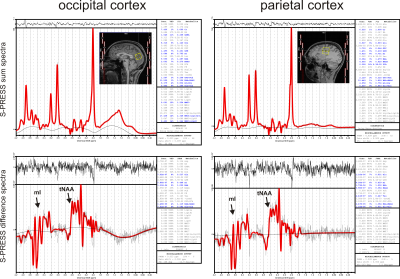 |
Glycine quantification via S-PRESS difference editing of myo-inositol
Thomas Lange, Michael Dacko
The quantification of glycine (Gly) with in vivo MRS is challenging due to the strong spectral overlap with myo-inositol (mI) so that only the concentration sum mI+Gly can be accurately measured with standard MRS methods at clinical field strengths. In this work, the distinction and quantification of mI and Gly is demonstrated with S-PRESS difference editing, which enables unequivocal detection of the strongly coupled mI resonances through suppression of the overlapping uncoupled Gly resonance.
|
|
1284.
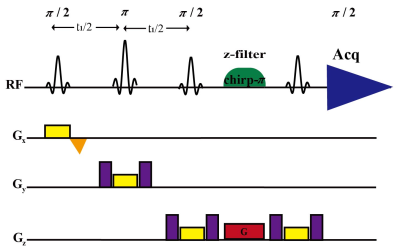 |
High resolution localized 1D homonuclear decoupled in phase MR spectroscopy via z-filtered 2D J-spectroscopy
Lin Yanqin, Bo Duan, Dan Tian, Qing Zeng, Zhong Chen
Proton 1D MR spectroscopy is an important tool in the study of a number of diseases. However, due to multiplet structure and narrow proton chemical shift range, 1D spectra become complicated for direct assignment and quantification. Homonuclear broadband decoupled spectra can be obtained by separating the chemical shift and J coupling information into orthogonal axes in the conventional JPRESS spectra. However, they suffer low resolution because of phase-twisted lineshape. Here, a J-resolved alike experiment with z-filtered module is introduced for the selection of in phase magnetization, and thus high resolution phase sensitive localized 1D spectra can be obtained.
|
|
1285.
 |
Macromolecule-suppressed GABA acquisition at 7T with commonly available Gaussian editing pulses.
Pallab Bhattacharyya, Mark Lowe
Co-editing of macromolecule(MM) resonances is a major problem in J-difference based editing (e.g. MEGA-PRESS) at 3T and lower field strengths. Symmetrical pulsing centered at the 1.7 ppm MM resonance alleviates this problem but results in loss of desired GABA signal, in addition to loss of unwanted MM signal, due to high bandwidth of frequency-selective editing pulses. Larger separation of editing pulses at 7T reduces the problem, but large chemical shift displacement errors, especially at low B1, make MEGA-PRESS non-viable at 7T. Using a low-power MEGA-LASER sequence, we measured macromolecule minimized GABA at 7T with editing pulses having bandwidths available in most scanners.
|
|
1286.
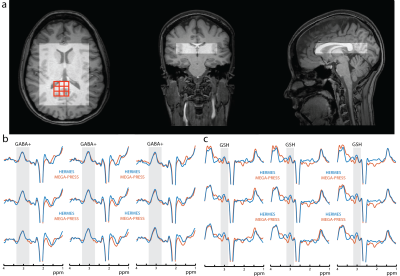 |
Simultaneous MRSI of GABA and glutathione using HERMES spectral editing at 3T
Kimberly Chan, Richard Edden, Georg Oeltzschner, Muhammad Saleh, Peter Barker
HERMES with single-voxel PRESS localization has been used to simultaneously edit multiple compounds. It’s often desirable to measure spectra from multiple brain regions, using MR spectroscopic imaging (MRSI). This study examined the feasibility of HERMES editing of GABA and GSH with a PRESS-localized MRSI sequence at 3T, and compared it to conventional MEGA-edited MRSI acquisitions. It’s found that adding symmetrical lipid suppression pulses to HERMES allows the sequence to be used in vivo and has an editing efficiency equivalent to that of separate acquisitions of GABA and GSH using MEGA-PRESS MRSI without an increase in measurement variability relative to MEGA-PRESS.
|
|
1287.
 |
High resolution mapping of GABA+ and Glx using motion-corrected, spiral-accelerated, edited 1D-semiLASER MRSI in the human brain at 7T
Philipp Moser, Bernhard Strasser, Lukas Hingerl, Michal Považan, Gilbert Hangel, Eva Heckova, Borjan Gagoski, Andre van der Kouwe, Ovidiu C. Andronesi, Siegfried Trattnig, Wolfgang Bogner
In vivo detection of gamma-aminobutyric acid (GABA) and glutamate (Glu), both major neurotransmitters in the human brain, benefits from the higher sensitivity and SNR at ultra-high field (7T) compared to lower field strengths. However, strong B1+ inhomogeneities and chemical shift displacement errors, as well as subject motion and carrier frequency drifts can significantly impair the experiment. We preliminarily propose the first high resolution full-slice in vivo mapping of GABA+ at 7T. Combining spatial-spectral spiral encoding for MRSI acceleration with B1-insensitive adiabatic pulses and real-time motion correction allows unprecedented high resolution J-difference editing at 7T in comparably short scan time.
|
|
1288.
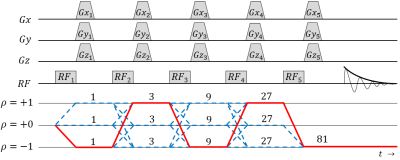 |
Optimized Crusher Design for Magnetic Resonance Spectroscopy
Karl Landheer, Christoph Juchem
Modern magnetic resonance spectroscopic (MRS) pulse sequences frequently overlook the issue of unwanted coherence pathways. A novel and robust algorithm which only requires input of the desired coherence(s) was developed to optimally crush all unwanted coherence pathways for any MRS pulse sequence. Experiments were performed on the GE BRAINO phantom comparing crusher schemes obtained from the literature with those obtained from the developed optimization algorithm for sLASER and MEGA-sLASER. The results demonstrate that the effects of unwanted coherences can be drastically reduced through the implementation of an optimized crusher scheme, without the need for additional or stronger crushers.
|
|
1289.
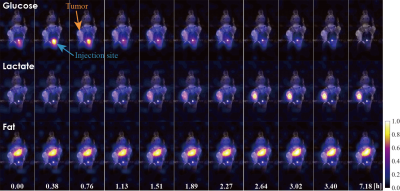 |
Improving time resolution in the imaging of metabolic dynamics using Compressed Sensing from 2D Heteronuclear Multiple Quantum Coherence
Utako Yamamoto, Hirohiko Imai, Kei Sano, Masayuki Ohzeki, Tetsuya Matsuda, Toshiyuki Tanaka
We propose a compressed sensing reconstruction method with high time resolution for imaging fast metabolic dynamics from sequential data measured using 2D 1H- 13C heteronuclear multiple quantum coherence (HMQC) MRSI. Optimization using the alternating direction method of multipliers (ADMM) is employed to incorporate prior knowledge about the substance distribution. The 2D-HMQC MRSI with pseudo-random undersampling is applied to tumor-bearing mice after the injection of [U-13C] glucose. From the resulting data, we successfully reconstruct time-series of the in vivo density of three substances (glucose, lactate, and fat) at a high time resolution of 2.25 min.
|
|
1290.
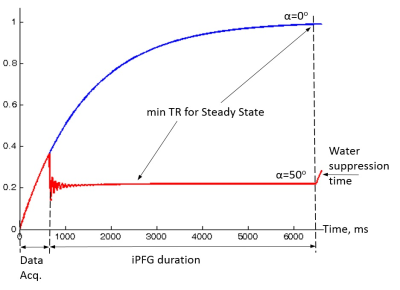 |
Fast In Vivo Metabolite T2 Quantification by RF-Driven Steady State
Ningzhi Li, Linqing Li, Yan Zhang, Jun Shen
MARzss method is a novel method for brain metabolite T2 quantification without varying echo time. This study evaluates the feasibility of shortening the scan time of the MARzss method by more than 80% using minimum TR and two-FA measurements. Phantom and preliminary in vivo studies show that metabolite T2 quantifications using two-FA measurements agree well with T2 values obtained by the originally proposed seven-FA measurements. In addition, Monte Carlo simulations indicate that under the same total scan time, the two-FA measurements can significantly improve the precision of T2 quantification.
|
|
1291.
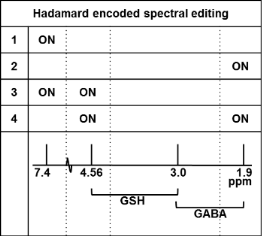 |
Test-retest reliability of real-time frequency and motion corrected Hadamard encoded spectral editing (CHASE)
Anna Lind, Vincent Boer, Mads Andersen, Esben Petersen, Anouk Marsman
Inhibitory neurotransmitter GABA and antioxidant GSH are suggested to be implicated in psychiatric and neurological disorders. Because of their relatively weak signals, spectral editing is necessary to assess GABA and GSH in the human brain. Hadamard encoding can be applied simultaneously for spectral editing of GABA and GSH. As both small metabolite signals and Hadamard encoding are highly susceptible to frequency drift and motion, real-time frequency and motion correction significantly improves spectral quality. The data obtained in this study so far suggest good test-retest reliability of real-time frequency and motion corrected Hadamard encoded spectral editing (CHASE) for GABA and GSH.
|
|
1292.
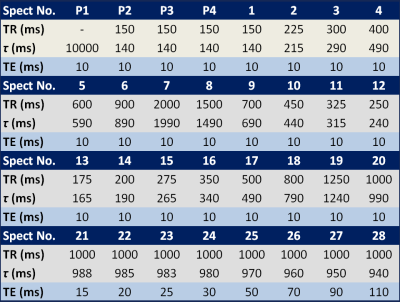 |
Flip Angle Corrected Multi-TR, Multi-TE 1H MR Spectroscopy
Gavin Hamilton, Alexandra Schlein, Claude Sirlin
Multi-TR, multi-TE 1H MRS estimates T1 and T2 of fat and water and liver proton density fat fraction in a single breath-hold. This approach uses a steady state solution, which assumes a perfect 90° pulse is generated which is not guaranteed in vivo, possibly introducing T1 errors. We introduce a flip angle corrected multi-TR, multi-TE 1H MRS sequence based on a non-steady state approach and demonstrate, in phantoms, that while the multi-TR, multi-TE MRS sequence estimates T1 dependent on the flip angle, the flip angle corrected multi-TR, multi-TE MRS sequence estimates T1 independent of flip angle.
|
|
1293.
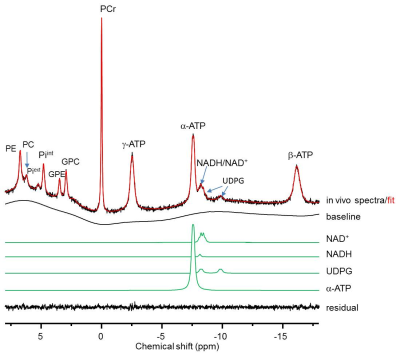 |
Accuracy and Reproducibility of NAD+, NADH and Redox Ratio Measurement in Human Brain by LCModel
Lijing Xin, Ozlem Ipek, Bernard Cuenoud, Maurice Beaumont, Maya Shevlyakova, Rolf Gruetter
The aims of this study were to test the feasibility of NAD+, NADH and redox ratio([NAD+/NADH]) measurement in vivo in the human brain at 7T using LCModel and to further evaluate the measurement accuracy and reproducibility. High 31P spectral quality was achieved and LCModel provides excellent fitting quality. Monte-Carlo simulations and test-retest experiments demonstrated good measurement accuracy and reproducibility with sufficient SNR achieved. The values are in agreement with those previously published. Therefore, LCModel can be used as an alternative tool to achieve automated and objective measurement of NAD+, NADH and redox ratio in human brain in vivo.
|
|
1294.
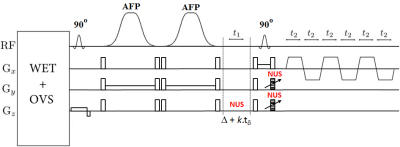 |
Accelerated Correlated Spectroscopic Imaging in Two Spectral-Three Spatial Dimensions with Slice-selective Adiabatic Refocusing Pulses in Human Calf Muscles
Manoj Sarma, Andres Saucedo, Christine Darwin, Neil Wilson, Zohaib Iqbal, Cathy Lee, Catherine Carpenter, Theodore Hahn, M. Albert Thomas
An optimized version of the five-dimensional (5D) echo-planar correlated spectroscopic sequence using an adiabatic full passage (AFP) RF pulse pair has been implemented on a 3T MRI/MRS scanner equipped with a 15-channel transmit/receive coil. The sequence was initially tested using a corn oil phantom. The calf muscle of twelve healthy subjects (age 27.5±3.1 years) and six diabetic type 2 subjects was studied (age 62.3±9.8 years). The AFP pulse pair enabled a sharper profile and minimal chemical shift misregistration. The localization of the volume of interest showed differential distribution of metabolites and lipids in human calf muscle and tibial marrow.
|
|
1295.
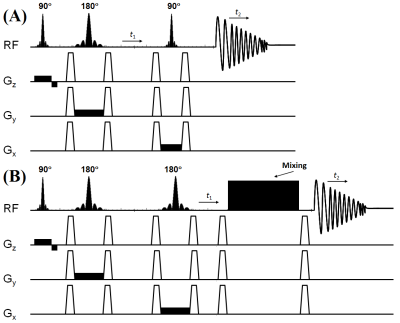 |
Uncovering Long Range J-coupled Lipid Resonances in Human Calf In-Vivo: Pilot Findings Using Localized Two Dimensional Total Correlated Spectroscopy
Manoj Sarma, Andres Saucedo, Christine Darwin, Cathy Lee, Ravinder Regatte, M. Albert Thomas
Based on the same principle of localized correlated spectroscopy (L-COSY) of coherence transfer during mixing period, total correlated spectroscopy (TOCSY) is a powerful technique that can provide correlations for both direct and long range coupled spins via relayed coherence transfer. Due to the SAR issue, the potential of TOCSY has not been fully exploited in-vivo and only few versions of TOCSY have been evaluated in brain. Here we have implemented a novel version of localized TOCSY technique for implementation in human calf muscle in-vivo, and compared results from three mixing strategies. Results are presented from a corn oil phantom, and in-vivo 2D spectra from 4 healthy volunteers and 1 diabetic patient obtained on 3T clinical platforms. We demonstrated that TOCSY can uncover the hidden relayed peaks, particularly that of IMCL/EMCL in calf muscle which can play an important role in better estimation of degree of unsaturation.
|
|
1296.
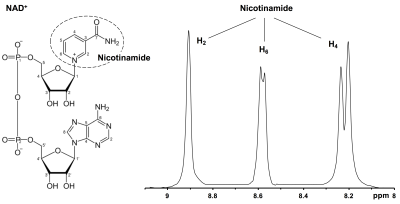 |
In vivo detection of NAD+ in human calf muscle at 7T using 28-channel knee volume coil
Puneet Bagga, Neil Wilson, Catherine DeBrosse, Hari Hariharan, Ravinder Reddy
Nicotinamide adenine dinucleotide (NAD+) is a ubiquitous molecule present in all cells and tissues of the body with an important role in the redox reactions and metabolism. Small changes in NAD+ levels may lead to oxidative stress and may be a cause for various disorders. NAD+ is usually be detected in vivo by 31P NMR spectroscopy. Recently, NAD+ measurement with 1H MRS in the human brain was demonstrated. In the present study, we show for the first time, in vivo single voxel localized 1H MRS detection of NAD+ from the human calf muscle at 7T.
|
|
1297.
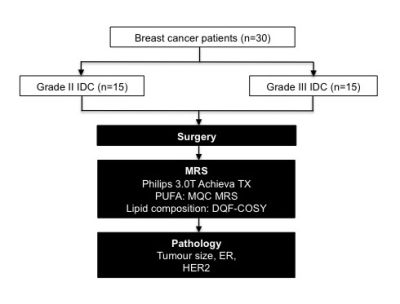 |
Profiling lipid composition in whole breast tumours using two dimensional (2D) double quantum filtered (DQF) correlation spectroscopy (COSY) and multiple quantum coherence (MQC) magnetic resonance spectroscopy (MRS)
Sai Man Cheung, Ehab Husain, Yazan Masannat, Vasiliki Mallikourti, Steven Heys, Jiabao He
Changes in lipid composition, such as polyunsaturated fatty acids (PUFA), have found to be potential biomarker of breast cancer. It has been shown that PUFA has a role in breast cancer initiation. The relationship in human between lipid composition and breast tumour grading warrants urgent investigation, as a pathway towards improved treatment. Conventional MRS suffers from overlap of nearby lipid and water peaks, and is insufficient for lipid composition measurement. We conducted double quantum filtered (DQF) correlation spectroscopy (COSY) to resolve lipid composition from the whole breast tumour, and multiple quantum coherence (MQC) MRS for further close investigation of PUFA.
|
|
1298.
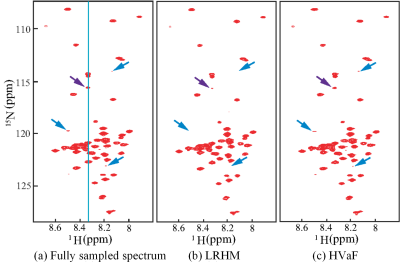 |
High Quality Magnetic Resonance Spectroscopy Reconstruction with Vandermonde Factorization on Low Rank Hankel Matrix
Xiaobo Qu, Jiaxi Ying, Di Guo, Jian-Feng Cai, Gongguo Tang, Zhong Chen
Magnetic resonance spectroscopy (MRS) is commonly converted from its free induction decay (FID) data with Fourier transform. How to reconstruct high quality spectra is one of the fundamental problems for MRS. In this work, a reconstruction method is proposed to explore the general exponential property of FID. Each exponential function of FID is explicitly enforced with the Hankel matrix Vandermonde Factorization (HVaF). This model is then applied to spectrum reconstruction of sparsely sampled FID in fast MRS. Results on synthetic and realistic MRS show that the new approach requires fewer data to allow successful reconstruction and provides better reconstruction on low-intensity signals than the state-of-the-art low rank Hankel matrix method. Thus, the new approach would be useful for faster data acquisition or recovery of weak spectral peaks in MRS applications.
|
|
1299.
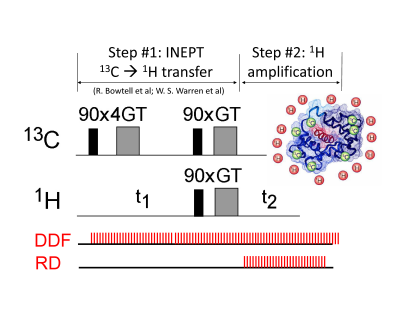 |
Indirect Detection and Spin Amplification of Non-Proton MRS and MRI by Solvent Proton Signals
Zhao Li, Yung-Ya Lin
A general indirect-detection and spin-amplification scheme has been developed to enhance the sensitivity of heteronuclear MRS and MRI based on dynamic instability of the solvent proton magnetization under collective feedback fields of radiation damping and the distant dipolar field. The heteronuclear solute spins are first detected by the solvent proton spins through various magnetization transfer mechanisms and serve as small “input” signals to perturb the solvent proton magnetization, which is prepared in an unstable state. The weakly detected signal is then amplified through subsequent nonlinear evolution of the solvent proton magnetization to achieve 10x SNR improvement for 13C MRS and MRI.
|
|
1300.
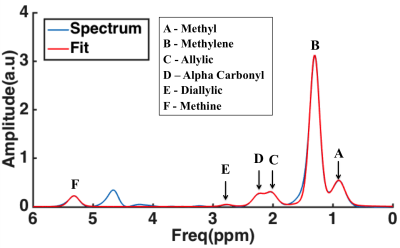 |
Reproducibility of the measurement of hepatic lipid composition with 1H MRS at 3T
Pandichelvam Veeraiah, Kay Roumans, Joachim E Wildberger, Patrick Schrauwen, Vera Schrauwen-Hinderling, Lucas Lindeboom
The total intrahepatic lipid (IHL) content can reliably be determined with 1H-MRS, but measuring lipid composition (saturated, mono- and poly-unsaturated fatty acids) is very challenging. At 3T the allylic peak is contaminated with the alpha-carbonyl methylene resonance, which hampers accurate measure of lipid composition. Recently, we developed a new approach to determine the lipid composition using prior knowledge to correct the signal intensity for alpha carbonyl group using methyl resonance. Here, we determined the in vivoreproducibility of our approach and robust quantification of lipid composition in a group of subjects with a wide range of total liver fat content.
|
|
1301.
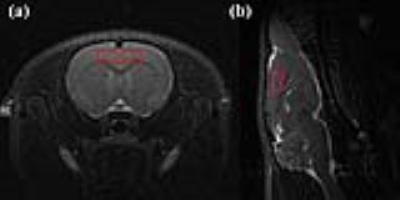 |
Preliminary study of proton magnetic resonance spectroscopy with multi-echo-time for simultaneous quantification and T2 measurement of glutamate.
Chi-Hyeon Yoo, Kyu-Ho Song, Song-I Lim, Dong-Choel Woo, Bo-Young Choe
This study presents our preliminary concept of multi-echo-time (TE) in vivo proton magnetic resonance spectroscopy (1H MRS) for the simultaneous quantification and T2 measurement of the brain metabolites, particularly glutamate. The feasibility of the proposed method was verified by comparing metabolite concentrations to that of conventional short-TE, and T2 relaxation times to that of conventional T2 measurement. Although TE points must be further optimized, the multi-TE in vivo 1H MRS could be used to simultaneously investigate the changes of brain metabolism and microenvironments in a scan time comparable to that of the conventional method.
|
|
1302.
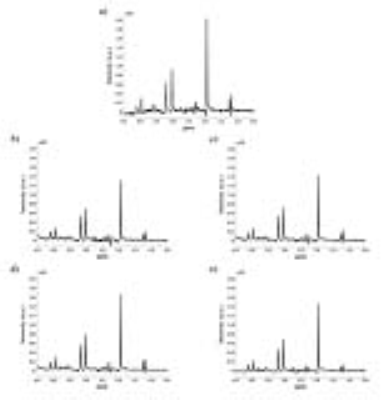 |
Feasibility of Echo Time Optimization for Glutamate and Myoinositol Detection using TE-Averaged PRESS Spectral Editing Technique in Human Brain at 3T.
Gokce Hale Hatay, Esin Ozturk Isik
This study aims to investigate the feasibility of echo time (TE) optimization for TE-averaged PRESS for faster detection of glutamate (Glu) and myoinositol (mI) in human brain at 3T. Proton MR spectroscopic imaging (1H-MRSI) data of a brain phantom and a healthy volunteer were acquired at 3T using 10 different TEs, which were selected based on prior Monte Carlo simulation results. TE-averaged PRESS spectra were created with best TE combinations, and metabolites were quantified in MATLAB. Our results indicated that TE-averaged PRESS with upto 5 TE’s could reliably detect separate Glu and mI metabolites.
|
|
1303.
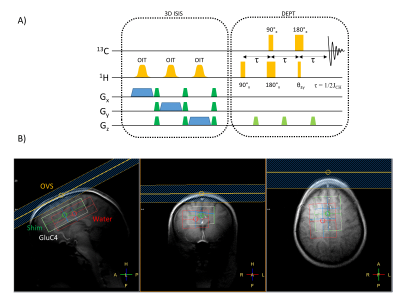 |
1H-localised 13C DEPT measurement of glutamate and glutamine turnover in human frontal lobe using [1-13C]glucose infusion at 7T
Bernard Lanz, Chen Chen, Carolina Fernandes, Liz Simpson, Adriana Anton, Mohammad Katshu, Mohan Rathnaiah, Andrew Peters, Ian Macdonald, Stephen Williams, Bill Deakin, Peter Liddle, Peter Morris
Human 13C MRS has recently shown its further potential in understanding neurological disorders. In the field of schizophrenia, 1H MRS has been applied with findings of abnormal concentrations of glutamate ?Glu? and glutamine ?Gln? in anterior cingulate cortex ?ACC?. It is therefore of interest to measure glutamate metabolism with 13C MRS in this brain region to get deeper understanding of these changes. In the present study, we applied localized 13C MRS at 7T upon [1-13C]glucose infusion, using a 13C/1H volume coil and polarisation transfer (DEPT) to test the feasibility of measuring glutamate turnover in ACC.
|
|
1304.
 |
Iterative Reconstruction of 23Na Multi-Channel Breast Data Using Compressed Sensing Combined with Anatomical 1H Prior Knowledge
Sebastian Lachner, Olgica Zaric, Matthias Utzschneider, Lenka Minarikova, Stefan Zbyn, Bernhard Hensel, Siegfried Trattnig, Michael Uder, Armin Nagel
An iterative reconstruction algorithm for sodium magnetic resonance imaging (23Na MRI) with multi-channel receiver coils is implemented and compared to a conventional gridding reconstruction. Based on compressed sensing (CS) it utilizes a total variation (TV(2)), combined with anatomical weighting factors (AnaWeTV(2)) to preserve known tissue boundaries. Simulated and measured 23Na multi-channel data sets of the female breast were reconstructed. The TV(2) and in particular the AnaWeTV(2) lead to an improved image quality, due to effective noise reduction and the highlighting of structure. The presented CS reconstruction is beneficial especially for high undersampling factors.
|
|
MRS/MRSI Reconstruction & Quantification
Traditional Poster
Spectroscopy & Non-Proton MR
Monday, 18 June 2018
| Exhibition Hall 1305-1335 |
08:15 - 10:15 |
|
1305.
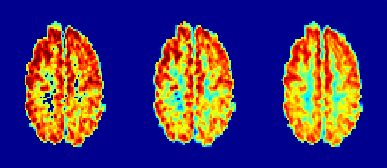 |
Evaluation of different postprocessing-based B0 inhomogeneity correction methods for application in 7T FID-MRSI
Stanislav Motyka, Philipp Moser, Bernhard Strasser, Lukas Hingerl, Michal Považan, Gilbert Hangel, Eva Heckova, Stephan Gruber, Siegfried Trattnig, Wolfgang Bogner
The information from B0 maps can be used to improve the spectral quality in MRSI. Two post-processing methods, SPREAD and odMRSI, were implemented and evaluated on: i) simulation model, ii) phantom data, and iii) high-resolution in vivo data acquired by 2D FID-MRSI with CAIPIRINHA acceleration at 7T. Both methods were capable to improve the spectral quality, however, the SPREAD only in high SNR situations which are not present in clinical reality. The spectral quality improvement brought by odMRSI was equivalent to the averaging of 6 averages but this improvement could not be directly translated into the same metabolic map quality.
|
|
1306.
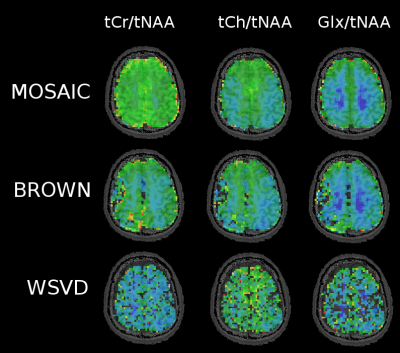 |
MOSAIC - a generalized multi-channel coil combination for 1H-MRSI via interleaved calibration scans
Philipp Moser, Bernhard Strasser, Lukas Hingerl, Michal Považan, Gilbert Hangel, Eva Heckova, Stephan Gruber, Siegfried Trattnig, Wolfgang Bogner
The optimal combination of signals from all receive elements is a prerequisite in MRSI especially at high field (≥7T), not only for SNR-efficient acquisition, but also for good parallel imaging reconstruction [1,2]. Phantom and in vivo experiments showed superior performance of MOSAIC including higher SNR, smaller FWHM and anatomically detailed metabolic maps compared to Brown and WSDV coil combination. MOSAIC is a flexible and robust approach for efficient MRSI coil combination under challenging conditions (B0≥7T, many coil elements, no reference coil, low SNR, possible spectral artifacts, motion/instability related artifacts, 1st-order phase error), especially with an outlook on parallel-imaging non-Cartesian MRSI.
|
|
1307.
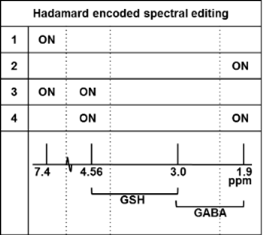 |
3D EPSI Hadamard spectral editing of GABA and GSH at 7T
Vincent Boer, Nam Lee, Anouk Marsman, Esben Petersen
A 3D MRSI sequence was developed for simultaneous editing of GABA and GSH using a Hadamard editing scheme at 7T. 3D MRSI was performed using a 1D echo planar spectroscopic readout (EPSI). Volume selection was perfomed using a sLASER volume selection box using adiabatic refocusing pulses.
|
|
1308.
 |
Dictionary-Learning Compressed Sensing Reconstruction for an Anisotropic 3D Density-Adapted Radial Acquisition Sequence
Matthias Utzschneider, Nicolas Behl , Sebastian Lachner, Andreas Maier, Michael Uder, Armin Nagel
Sodium magnetic resonance imaging requires dedicated acquisition techniques and reconstruction approaches due to the low in-vivo signal and ultra-short relaxation times. For this purpose a compressed sensing reconstruction technique using dictionary learning is applied to raw data acquired with an anisotropic 3D density-adapted radial acquisition sequence. The anisotropic acquisition allows an adjustment of projections in different directions to increase the in-plane resolution. In the following evaluation the possible benefits of the compressed sensing reconstruction using the increased in-plane resolution are shown for in-vivo sodium magnetic resonance imaging and quantification of 23Na.
|
|
1309.
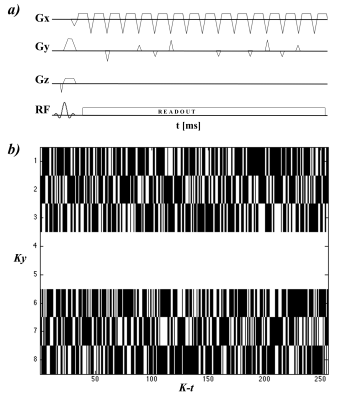 |
Accelerated in vivo Phosphorus Magnetic Resonance Spectroscopic Imaging combining flyback-EPSI and Compressed Sensing
Alejandro Santos Diaz, Michael Noseworthy
Long acquisition time is still a major limitation in performing clinical 31P MRSI studies. To overcome this limitation we implemented and tested a pulse sequence that combines flyback EPSI readout and compressed sensing (CS). Our results, in human skeletal muscle, show the feasibility of performing 31P MRSI using this combined approach.
|
|
1310.
 |
Optimization of Radial Echo Planar Spectroscopic Image Reconstruction for Hyperpolarized [1-13C]-Pyruvate Imaging
Joshua Niedzielski, Chang-yu Sun, Keith Michel, Christopher Walker, Samuel Einstein, James Bankson
Radial echo planar spectroscopic imaging (EPSI) is an efficient method for imaging hyperpolarized (HP) substrates. However, symmetric data sampling between even/odd echo components can lead to ghost artifacts that can interfere with spectral undersampling strategies that enhance SNR. The purpose of this study was to optimize the acquisition and reconstruction of a symmetric radial EPSI sequence for dynamic HP [1-13C]-pyruvate imaging. In this work, we show that the generalized Fourier transform technique preserves spectral bandwidth, reduces ghost and aliasing artifacts, and improves SNR compared to alternative strategies that separately consider even and odd echo subsets.
|
|
1311.
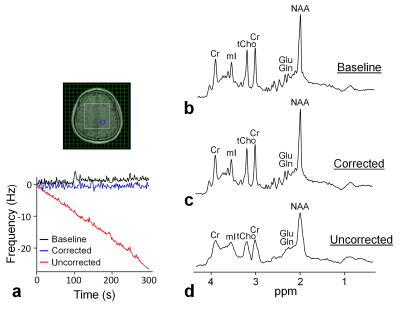 |
In vivo validation of OVS-localized navigator for prospective frequency correction in MRSI
Chu-Yu Lee, In-Young Choi, Phil Lee
Data acquisition for MRS and MRSI requires a stable scanner frequency during the relatively long scan time. However, gradient heating and subject motion during the scan result in drifts of the scanner frequency. The effects of frequency drifts include reduced SNR, broad linewidth, and errors in spatial encoding and metabolite quantification. We had recently proposed a new navigator approach: outer volume suppression (OVS)-localized navigator, to prospectively correct frequency drifts without introducing SNR losses, overcoming the shortcomings of previous PRESS-localized navigator. The purpose of this study is to validate the OVS-localized navigator approach through the comparison with non-localized navigator and the quantitative evaluations of spectral quality and metabolite concentrations in 10 healthy subjects.
|
|
1312.
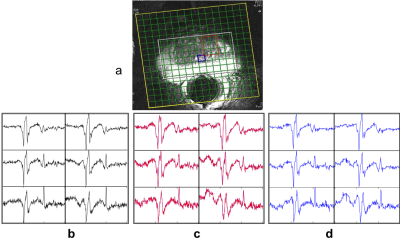 |
Reconstruction of motion affected prostate MRSI data using navigators and compressed sensing
Rashmi Reddy, Ryan Kalmoe, Greg Metzger, Sairam Geethanath
This work focuses on reconstruction of 2D prostate in vitro and in vivo MRSI data. Motion affected phase encodes are tracked using a free induction decay navigator. The proposed work utilizes Compressed Sensing (CS) reconstruction technique to compensate for the loss of motion affected information. Comparison between data without motion considered as ground truth (GT) is performed with data with motion and CS reconstructed data. Qualitative and quantitative performance measures indicate improvement in spectral quality with the application of the navigator led CS MRSI reconstruction. Current and future work involves the application of this method on an increased sample size.
|
|
1313.
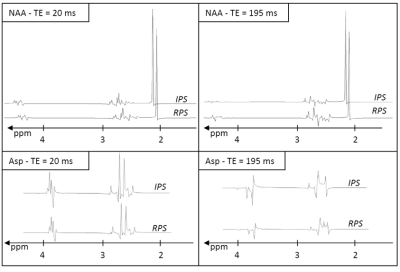 |
Quantitative evaluation of systematic bias in clinical MRS introduced by the use of metabolite basis sets simulated with ideal RF pulses
Maike Hoefemann, Jan Willem van der Veen, Roland Kreis
The purpose of this study was to quantitatively evaluate biases caused by the use of ideal PRESS simulations. Metabolite basis spectra were simulated for an ideal PRESS sequence as well as with real shaped RF-pulses. Theoretical ground truth spectra were constructed for different TE and shim settings. They were fitted using both basis sets. It is shown that the fitting accuracy decreases when using ideal simulations and they depend on TE and metabolite. Therefore, simulation of basis sets should include the effects of the real pulse shapes even for the presented case of short TE and fairly large B1 amplitude.
|
|
1314.
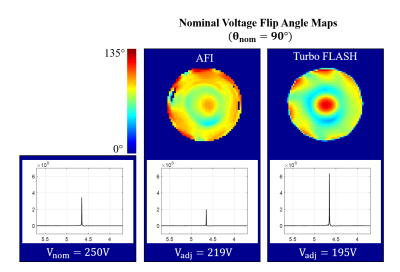 |
Toward Absolute Quantification Using External Reference Standards at 3T and 9.4T
Andrew Wright, Sahar Nassirpour, Paul Chang, Anke Henning
Absolute quantification is a challenge with many paths to reach the final goal of quantifying metabolites in absolute units (e.g. Molarity and molality). Utilizing an external reference standard (ERF) is an attractive method for quantifying in vivo metabolites due to the ability for direct comparison between a known concentration of a metabolite and the in vivo data. A major concern in utilization of an ERF is the differences in coil loading between in vivo and in vitro measurements. To that end, this work describes a method to calibrate and adjust the transmitter voltage in order to maximize signal detection independently of coil load.
|
|
1315.
 |
On the exploitation of slow macromolecular diffusion for baseline estimation in MR spectroscopy using 2D simultaneous fitting
André Döring, Victor Adalid, Chris Boesch, Roland Kreis
The slow diffusivity of macromolecules was exploited in 2D signal modeling with FiTAID to estimate the macromolecular baseline in MRS of human brain. Two approaches were used for baseline modeling: (i) a predefined model derived from high-field and T1-based baseline determination and (ii) a model-free description by equally spaced Voigt resonances. Inspection of fit residues and comparison with literature reveals that the second model is more appropriate.
|
|
1316.
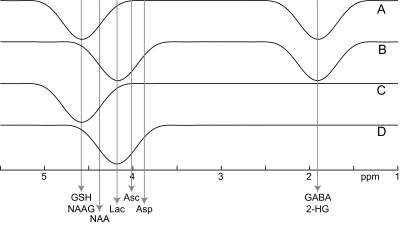 |
Simultaneous modeling of sum and difference spectra improves quantitative outcomes for edited MRS
Daniel Rimbault, Georg Oeltzschner, Ali Alhamud, Ernesta Meintjes, Richard Edden
J-difference-edited MR spectroscopy allows for the detection of several low-concentration compounds at 3T, but suffers from long acquisition times. Multiplexed editing experiments provide simultaneous detection of two or three metabolites by differentially modulating the spin systems of interest, and separating edited signals into distinct sum or difference spectra. For a novel multiplexed experiment (HERCULES), with simulated metabolite basis functions we demonstrate that simultaneously modeling the sum and difference spectra results in comparable metabolite levels with lower coefficients of variation, compared to separate modeling of the sum and difference spectra.
|
|
1317.
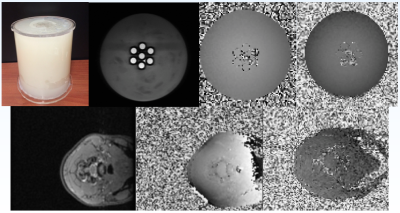 |
The Effect of B0 and B1+ Inhomogeneities on Spinal Cord MRS
Nicholas Simard, Aimee Nelson, Michael Noseworthy
Spinal cord 1H MR Spectroscopy (1H-MRS) is a promising method for musculoskeletal research. However, due to the spine’s anatomical location there is a significant degradation of signal quality due to magnetic field inhomogeneities, rendering most MRS approaches inaccurate. Although there has been measurement of ΔB0 in spinal cord MRS, there are no comprehensive assessments of temporal changes in B0 and B1+ relating physiological disturbances with MRS accuracy. Thus our goal was to continually measure temporal changes in B0and B1+ during the length of a typical MEGA-PRESS scan (10min).
|
|
1318.
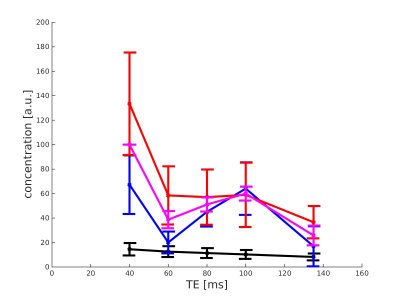 |
Quantification of Glutamate and Glutamine in the healthy brain via 1H in-vivo CSI MRS using LCModel is not reliable.
Simon Maennlin, Rupert Kolb, Anja Stierl, Uwe Klose
Glutamate and glutamine play an important role in CNS. Both are quantifiable via 1H in-vivo MRS, although a correct, separate quantification of both metabolites is often very challenging. In this study, 1H in-vivo CSI MRS was performed on ten healthy subjects, using the CSI sequences PRESS and Semi-LASER with TE=40ms,60ms,80ms,100ms and 135ms at 3T. The inner 64 spectra of each CSI matrix at each TE were averaged to a single spectrum. Averaged spectra were analysed using LCModel. The quantification of glutamate and glutamine, using this method, which is also a popular approach in MRS research, was shown to be inconsistent.
|
|
1319.
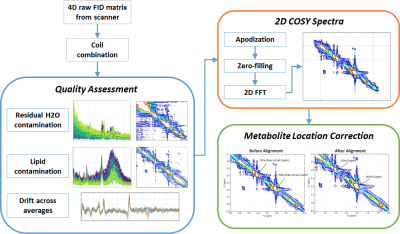 |
Novel methodology for processing, quality assessment, and artifact mitigation of raw 2D Correlation Spectroscopy data
Laura Mariano, Marcia Louis, Benjamin Rowland, Huijun Liao, Kristin Heaton, John Irvine, Alexander Lin
2D Correlation Spectroscopy (COSY) can be used to identify and study coupled resonances that cannot be observed or distinguished in 1D NMR spectra. However, resources and literature on best practices for processing raw 2D COSY data are limited. In this work, we describe a novel pipeline of signal processing algorithms and visualizations for quality assessment and artifact mitigation designed specifically for raw 2D COSY data, including detection of residual H2O and lipid contamination, correction for drift across averages, and peak location correction to enable more accurate comparisons of metabolites across subjects.
|
|
1320.
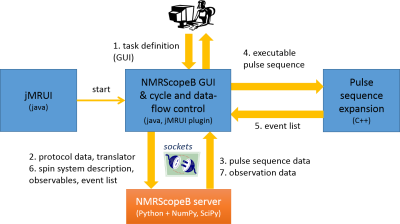 |
NMRScopeB – an open-source simulator for metabolite quantitation and pulse sequence development
Zenon Starcuk, Jana Starcukovį
The architecture and function of the release version of a spectroscopic simulator NMRScopeB is described. It includes the jMRUI-related GUI and an open-source calculation server communicating with the kernel via sockets. While standard metabolite set simulations needed for quantitation by jMRUI or LCModel can be prepared in a few steps, more complex research task can be handled as well. The operation is described by control and data flow charts. After a period of beta-testing, the simulator is released as part of the recent jMRUI package.
|
|
1321.
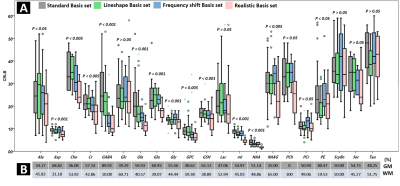 |
Implications of magnetic susceptibility difference between grey and white matter for spectroscopy quantification at 7T.
Donghyun Hong, Jack van Asten, Seyedmorteza Rohani Rankouhi, Jan-Willem Thielen, David Norris
Magnetic susceptibility differences between grey matter (GM) and white matter (WM) can potentially affect lineshapes and chemical shifts in single voxel spectroscopy. Hitherto, analytical techniques such as LCModel assumed a single lineshape per voxel. Separated GM and WM signals using multi-echo GRE image sequence in combination with literature values for the metabolite distribution between GM and WM enable to construct a realistic basis set for LCModel. With this information we can test how magnetic susceptibility induced lineshape modification affects metabolic quantification, which uses spectral prior knowledge.
|
|
1322.
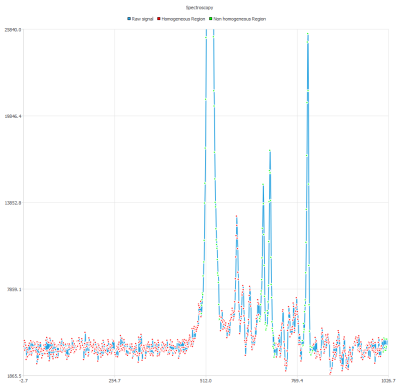 |
Spectral denoising for MR Spectroscopy using orthogonal polynomials
Mathieu Naudin, Benoit Tremblais, Carole Guillevin, Rémy Guillevin, Christine Fernandez-Maloigne
We propose a new methodology to denoise MRS spectrum with a focus on the acquisition time diminution. Using a discrete orthogonal polynomials, we detect two types of areas : homogenous and non-homogenous (metabolite peaks). Once these areas detected, we compute the Noise Level Function (NLF). Then, using the NLF, we use orthogonal polynomials to reconstruct a signal with a strategy for each type of area. As results, a denoising method is provided and it helps to correct the noise due to the acquisition time diminution with a good metabolite peaks conservation.
|
|
1323.
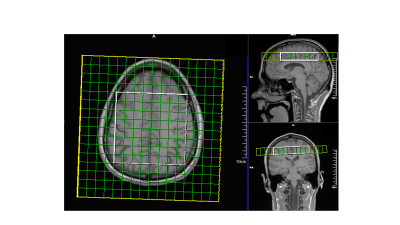 |
Metabolite quantitation using water-scaling corrected with Magnetic resonance fingerprinting
Ryan Larsen, Joseph Holtrop, Brad Sutton
Quantitation of MRSI data using water-scaling requires correction of the water signal for relaxation and CSF partial volume effects. We demonstrate the use of a rapid MRF sequence to characterize the water signal used to quantify MRS data, which we call WAter-scaling Quantification using MRF (WAQ-MRF) scan. WAQ-MRF provides subject-specific corrections of partial volume and relaxation effects for water-scaled data. By adding a one minute scan to a standard MRSI acquisition it is possible to eliminate the need for assuming literature values of relaxation and proton density to correct the water signal.
|
|
1324.
 |
Spectral Quantification for Multiple-TE Spectroscopy Using Spectral Priors and Measured Lineshape Distortion Function
Fan Lam, Yudu Li, Zhi-Pei Liang
This work presents a new method for quantifying multiple-TE/two-dimensional spectroscopy data, characterized by the use of spectral priors obtained by quantum mechanical simulations and an experimentally measured lineshape distortion function derived from a set of multi-TE water spectroscopic data. Results from in vivo J-resolved spectroscopy data demonstrated the excellent fitting produced by the proposed method, and improved robustness over a standard parametric-model-based method. With further developments, such as extensions to different sequences and Cramer-Rao bound analysis, the proposed method should prove useful for a range of 2D spectroscopy experiments.
|
|
1325.
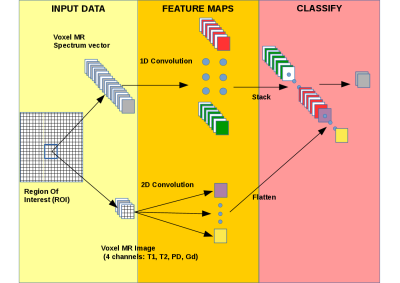 |
Classification of brain tumors by 1H MRSI and MRI using convolutional neural networks
Jacopo Acquarelli, Arend Heerschap, Geert Postma, Twan van Laarhoven, Jeroen Jansen, Elena Marchiori, Lutgarde Buydens
Several machine learning approaches have been used to classify brain tumors using MR images and spectra. Here we explore the specific properties of convolutional neural networks (CNN) for this task. We designed a CNN that could be trained on combined MR image and spectroscopic image data by exploiting their specific properties (spatial and spectral locality). Using a ‘leave-one-out’ validation, we demonstrate that our method outperforms state-of-the-art classification methods to distinguish tumor grades. These results demonstrate that CNNs are a powerful approach for tumor classification using MRSI data.
|
|
1326.
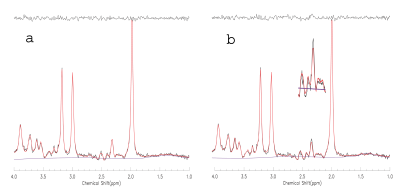 |
Highly Accelerated Simulation of Model Spectra for TE-Averaged Spectral Fitting
Yan Zhang, Jun Shen
One-dimensional projection method was applied to the simulation of spatially localized J-resolved magnetic resonance spectroscopy with real RF pulses. As a comparison, the same pulse sequence was simulated using non-localized ideal RF pulses. The resultant TE-averaged spectra of glutamate were compared with phantom experiment at 3T. Conspicuous differences between ideal pulse simulated spectrum and phantom spectrum were found. For vivo comparisons, metabolite quantification was performed with real RF pulse basis set and ideal pulse basis set, respectively. Real RF pulse generated basis set significantly improved the reproducibility of glutamate quantification in vivo.
|
|
1327.
 |
How does inclusion of different macromolecular baseline models affect reproducibility of 1H-FID MRSI in the brain at 7T?
Eva Heckova, Ursel Antpusat, Michal Považan, Bernhard Strasser, Gilbert Hangel, Lukas Hingerl, Philipp Moser, Stephan Gruber, Siegfried Trattnig, Wolfgang Bogner
The goal was to investigate how the use of different macromolecular baseline models affects both the accuracy and test-retest reproducibility of metabolite quantification for clinically attractive FID-MRSI scan with in-plane resolution of 3.4 x 3.4 mm2 and acquisition time of 5 min. We confirmed that our 1H-FID-MRSI sequence provides information about abundance and spatial distribution of several neurometabolites with high accuracy. Including the information about the macromolecular background into the quantification process does not decrease its reproducibility.
|
|
1328.
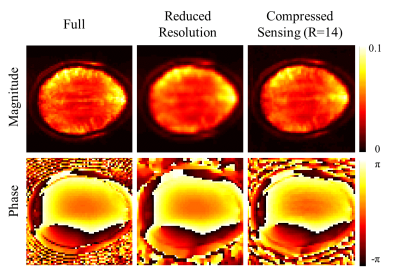 |
Highly Accelerated (R=14) Water Reference Acquisition for High Resolution 1H MRSI using Compressed Sensing
Paul Chang, Sahar Nassirpour, Anke Henning
In this study, the acquisition of a high resolution (64x64) water reference MRSI data is accelerated by a factor of R=14 using compressed sensing. The results show that this highly accelerated water reference can reliably be used for eddy current and phase correction purposes, as well as internal referencing and quantification. This enables the acquisition of the high resolution water reference MRSI data in 80 seconds at 9.4T.
|
|
1329.
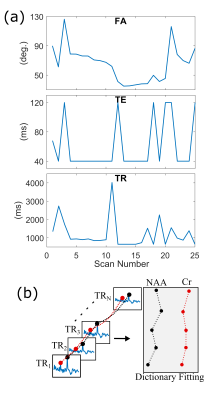 |
MRF in Single Voxel Spectroscopy: Signal to Noise Ratio or Dictionary Length - Which is more important?
Alexey Kulpanovich, Assaf Tal
We use MR spectroscopic fingerprinting (MRSF) to quantify T1,T2 and concentration addressing the tradeoff between fingerprint lengths and averaging. Methods. MRSF using 25, 50 and 100 fingerprint lengths were compered to inversion recovery (IR) and multi-TE using Monte-Carlo simulations and in-vivo experiments. Bias and variance were estimated for NAA, Creatine and Choline. Results. Simulations of all MRSF sequences show better accuracy and bias over IR. In-vivo experiments show improved T1 and concentration estimation. Conclusion. The low SNR emphasizes the tradeoff between fingerprint length and averaging. The In-vivo results show clear advantage using shorter fingerprint and increasing the SNR.
|
|
1330.
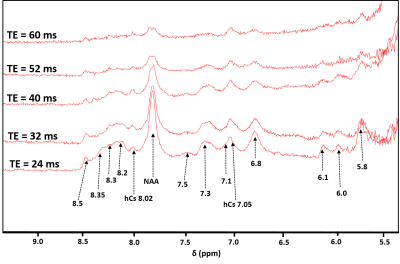 |
Estimation of T2 Relaxation Times of Downfield Peaks in Human Brain at 9.4 T
Saipavitra V. Murali Manohar, Tamas Borbath, Nicole Fichtner, Ioannis Angelos Giapitzakis, Daniel Zaldivar, Roland Kreis, Anke Henning
T2 relaxations times for the downfield metabolites in human brain 1H MR spectra were estimated at 9.4 T. A possible new peak at 8.35 ppm with rapid T2 decay is reported. Due to the use of a non-water suppressed MRS method, the T2 of slowly exchanging peaks could be assessed. The shorter T2 relaxation times in the downfield compared to the upfield spectral areas leads us to suspect a macromolecular contribution, while also exchange effects may contribute to the short apparent T2s.
|
|
1331.
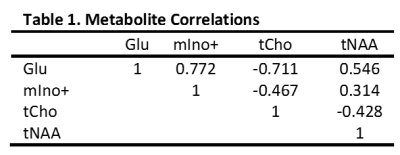 |
Multivariate Analysis of Developmental-Dependent Differences in Metabolites in White and Gray Matter: An Ultra-Short TE 1H MRS Study at 3T
Jack Knight-Scott
Application of multivariate analysis of variance (MANOVA) to a developmental data set of 1H spectra from white and gray matter brain tissue shows not only significant tissue differences but also significant gender and age differences. By specifically controlling for metabolite correlations, MANOVA results show higher sensitivity and power than individual ANOVAs.
|
|
1332.
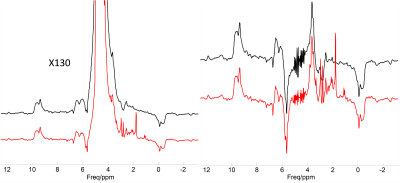 |
A comparison of reference-based methods for removing artifacts in non-water-suppressed 1H MRSI data
Zhengchao Dong, Feng Liu, Min Li, Matthew Milak, Sachin Jambawalikar
Sideband artifacts is the major obstacle to 1H MRSI without water suppression. To remove the sideband artefacts, several reference-based methods have been proposed, in which the reference signals are acquired from a water phantom with identical experimental parameters as those of in vivo scan are acquired. The reference-based methods do not suffer scan time penalty and they are compatible with any accelerated sequences such as SENSE-SI. The aim of the present work is to improve and compare the performance of two kinds of reference-based methods, namely, the phase compensation method and the artifact subtraction method.
|
|
1333.
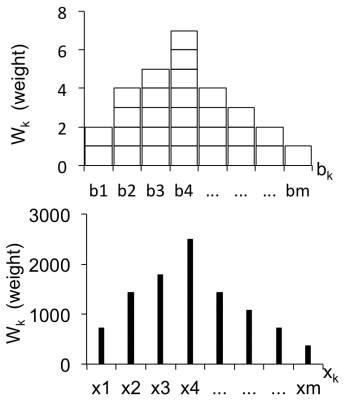 |
Conditions for extracting statistical descriptors from MR spectra characteristic of heterogeneous materials such as biological tissue
Norbert Lutz, Monique Bernard
Materials such as biological tissue are often characterized by considerable heterogeneity. This can manifest itself in significant variability of certain physicochemical parameter values across the measured volume. If the chemical shift of a particular MR resonance varies systematically with such a parameter, the resulting lineshape can be used to quantitatively characterize the heterogeneity with respect to this parameter. This is achieved by transforming the MRS lineshape into a curve representing the statistical distribution of the parameter values in question, followed by the derivation of a histogram. We study here two important conditions for the statistical evaluation of such spectrum-derived histograms.
|
|
1334.
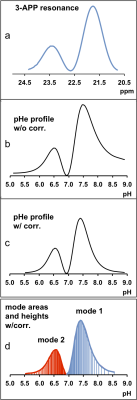 |
Effects of non-linearity correction on statistical descriptors of pH heterogeneity, obtained from 3-APP and inorganic phosphate resonances of tumor 31P MR spectra
Norbert Lutz, Monique Bernard
We recently presented a method for extracting statistical descriptors of pH heterogeneity from lineshapes of pH-sensitive 31P MRS resonances. The first step in this analysis is the conversion of the resonance in question into the corresponding pH profile. The latter is then corrected for non-linearity between chemical shift and pH. However, this procedure is insufficient since the unequal spacing of the digital points making up such pH profiles needs to be compensated for by appropriate weighting. Exact statistical descriptor values are of importance in quantification of tissue pH heterogeneity, an issue that has received major attention in recent cancer research.
|
|
1335.
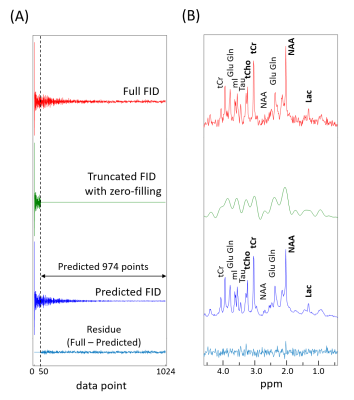 |
Restoration of truncated FID by machine learning
Hyochul Lee, Hyeonjin Kim
The potential applicability of a recurrent neural network (RNN) in the reconstruction of spectra from truncated FIDs was explored. A RNN was trained on a set of simulated full FIDs with varying metabolite concentrations. Then, the performance of the trained RNN was tested on severely truncated FIDs (~95% truncation). Our preliminary study suggests that RNNs may be used in the restoration of truncated FIDs and thus reconstruction of spectra including tiny multiplets. A well trained RNN may be applicable to the situations where data sampling is highly limited such as in cardiac MRS and spectroscopic magnetic resonance fingerprinting (sMRF).
|
|
Spectroscopy: NMR & Other
Traditional Poster
Spectroscopy & Non-Proton MR
Monday, 18 June 2018
| Exhibition Hall 1336-1345 |
08:15 - 10:15 |
|
1336.
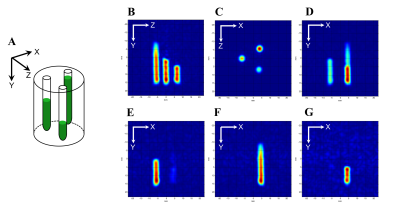 |
Time-domain EPR imaging with slice selection
Ayano Enomoto, Ken-ichiro Matsumoto, Shun Kishimoto, Shingo Matsumoto, Murali Krishna, Nallathamby Devasahayam
The slice selection imaging has advantages of reducing imaging time and obtaining optimum dynamic range in image for EPR imaging as well as for MRI. However, the slice selection using a selective pulse, which is used in MRI, is difficult to implement in EPR imaging because of ultra-fast relaxation time compared to gradient settling time. Therefore, we used a modulated gradient field to achieve slice selection in pulsed EPR imaging in this study. We demonstrated the slice selection imaging with tubes and a living mouse to show the effect of slice selection in pulsed EPR imaging.
|
|
1337.
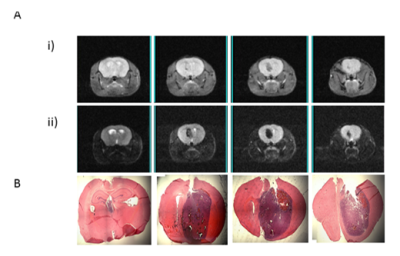 |
Metabolic characteristics of oncogenically transformed mouse neural progenitor cells using one dimensional 1H NMR
Magretta Adiamah, Liam Mistry, Andrew Houlton, Elizabeth Stoll, Ross Maxwell
Metabolic profiles of oncogenically transformed neural progenitor cells (NPCs) derived from 3 and 12 month old mice were evaluated using one dimensional 1H NMR spectroscopy. Principal component analysis revealed two distinct clusters which corresponded to the differently-aged NPCs. Metabolites identified in these cell lines were similar but differed in their relative abundance. The 3 month NPCs were characterised by high lipid CH2, creatine and choline. The metabolic signature of 12 month NPCs featured high levels of taurine, myo-inositol and branched-chain amino acids. This data suggests alterations in metabolic phenotype of aged NPCs which may arise from differences in enzymatic capacity.
|
|
1338.
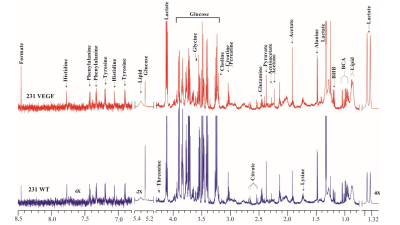 |
Gene Expression Profiling to Understand the 1H MRS Characterization of the VEGF Metabolic Secretome from a Triple Negative Human Breast Cancer Xenograft
Santosh Bharti, Balaji Kirshnamachary, Louis Dore-Savard, Brett Stark, Aleksander Popel, Zaver Bhujwalla
Vascular endothelial growth factor (VEGF A) is a potent regulator of angiogenesis, invasion, and metastasis, especially in breast cancer. Secreted VEGF that forms a part of the interstitial milieu along with other metabolites shapes the microenvironment. Here, using 1H MR spectroscopy and microarray, we have characterized the metabolic and gene signature of the tumor tissue derived from MDA-MB-231 cells that stably overexpressed VEGF gene. Metabolic changes supported by gene array data provide new insight into the role played by VEGF in breast cancer progression
|
|
1339.
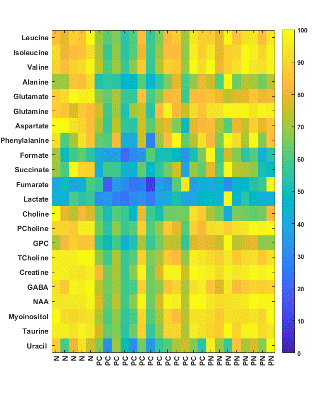 |
1H MRS Reveals Major Changes in Brain Metabolites Induced by Human Pancreatic Cancer Xenografts
Santosh Bharti, Paul Winnard Jr., Yelena Mironchik, Marie-France Penet, Anirban Maitra, Zaver Bhujwalla
Our ongoing efforts are focused on understanding systemic metabolic changes that occur during cancer-induced cachexia using human pancreatic ductal adenocarcinoma (PDAC) xenografts, since the syndrome occurs with the highest frequency and severity in PDAC. We used 1H MRS to analyze brain metabolite levels in mice with and without cachexia inducing human PDAC xenografts. Spectra revealed depletion of several metabolites, including neurotransmitters, in cachectic mice. These findings provide new insights into disruption of brain metabolism that may compromise central nervous system (CNS) function. Identifying alterations of brain metabolism may provide novel interventions to prevent or reduce CNS injury and cachexia.
|
|
1340.
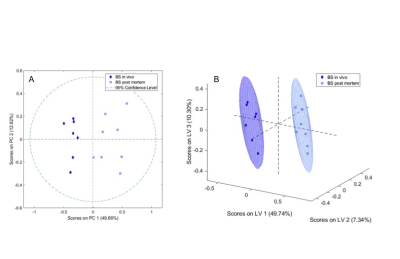 |
Effect of sampling method on HR-MAS NMR spectra of caprine brain biopsies
Annakatrin Häni, Gaelle Diserens, Anna Oevermann, Peter Vermathen, Christina Precht
Metabolic profiling of tissue biopsies using HR-MAS NMR has potential diagnostic and prognostic value, but alterations in the biochemical profile due to factors such as sampling method may lead to misinterpretation. Therefore we investigated the effect of two different sampling methods in normal caprine brain tissue, in vivo sampling by stereotactic biopsy and direct post mortem surgical sampling. We found significant differences between the two biopsy types with elevated lactate and creatine, and altered choline-containing compounds. We conclude that metabolite alterations depend on sampling methods and suggest the use of in vivo biopsy in animal models.
|
|
1341.
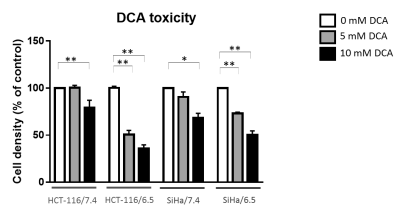 |
13C-NMR to study cancer cell metabolic plasticity following PDK inhibition. Influence of dichloroacetate and long-term exposure to acidic environment on glucose and glutamine metabolic pathways.
Céline Schoonjans, Nicolas Joudiou, Cyril Corbet, Olivier Feron, Bernard Gallez
Many cancer cells present an exacerbated glycolytic flux that provides advantage for growth and leads to extracellular acidosis. Dichloroacetate (DCA), a PDK inhibitor, shifts metabolism from glycolysis to glucose oxidation and decrease various cancer cells lines proliferation. However, as tumor cells are presenting metabolic plasticity, PDK inhibition may lack efficacy. To measure metabolic adaptations of cancer cells to acidic environment and in response to DCA, we studied metabolic fluxes using 13C-NMR spectroscopy. With this technology, we measured differences in metabolic profiles between parental cancer cells line and acidic clones and we quantified specific changes in metabolism following DCA treatment.
|
|
1342.
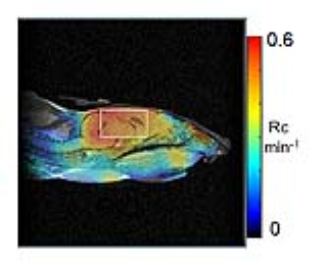 |
Non-invasive mapping of glutathione levels in mouse brains by electron paramagnetic resonance (EPR) imaging
Miho Emoto, Hirotada Fujii, Hideo Sato-Akaba
Glutathione (GSH) is an important antioxidant that can protect cells under oxidative stress. Thus, a non-invasive method to measure GSH levels in live animals is needed. To map the levels of GSH in mouse brains, a new method using electron paramagnetic resonance (EPR) imaging with nitroxide imaging probes was developed. By analyzing the relationship between reduction rates for nitroxides in brains measured by EPR and brain GSH levels measured by biochemical assay, pixel-based mapping of brain GSH levels was successfully obtained. The newly developed method was applied to a kindling mouse model of epilepsy to clarify the role of GSH.
|
|
1343.
 |
Comparing the Reproducibility of Commonly Used Magnetic Resonance Spectroscopy Techniques to Quantify Cerebral Glutathione at 3 T
Andrea Wijtenburg, Jamie Near, Stephanie Korenic, Frank Gaston, Hongji Chen, Mark Mikkelsen, Robert McMahon, Peter Kochunov, Elliot Hong, Laura Rowland
Cerebral glutathione (GSH), a marker of oxidative stress processes, has been quantified in neurodegenerative diseases and psychiatric disorders using proton magnetic resonance spectroscopy. However, no studies to date have compared the reproducibility of the most commonly used magnetic resonance spectroscopy techniques for GSH quantification. Here, we scanned ten healthy adults twice and acquired spectroscopic data using PRESS, PR-STEAM, SPECIAL, and MEGA-PRESS at 3 Tesla. We assess reproducibility via mean coefficients of variation (CV) and mean absolute difference (AD).
|
|
1344.
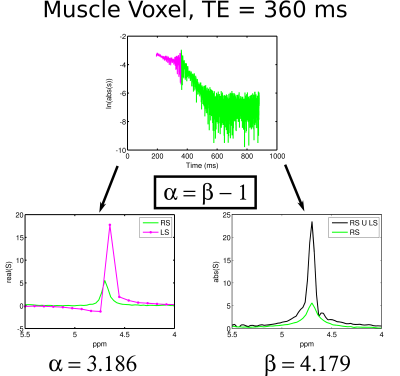 |
On spectrally selective measurements of irreversible and reversible transverse relaxation rates from single voxel, single echo time PRESS acquisitions
Robert Mulkern, Mukund Balasubramanian
We developed a methodology to measure the reversible and irreversible transverse relaxation rates R2' and R2, respectively, of multiple spectral peaks from spectroscopic sampling of both sides of a single spin echo. The methodology was applied to resonances in muscle and brain and the irreversible relaxation rates R2 were compared with conventional measurements made from right side only spectra acquired at multiple PRESS echo times.
|
|
1345.
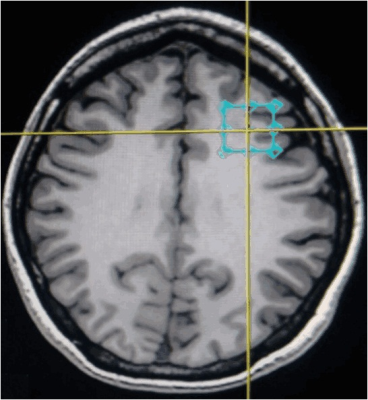 |
Aberrant Glutamatergic Neurotransmission in the Left Dorsolateral Prefrontal Cortex in Patients with Mild Cognitive Impairment: Preliminary Evidence from Task-Based Proton Magnetic Resonance Spectroscopy
Anupa A Vijayakumari, Bejoy Thomas, Ramshekhar Menon, Chandrasekharan Kesavadas
Much less is known about the changes in glutamate during working memory (WM) in patients with mild cognitive impairment (MCI). In this study, we aimed to understand the glutamatergic response to functional activation in patients with MCI and healthy subjects (HS) during WM. The changes in glutamate were examined before, during, and after the WM task in both groups using point resolved spectroscopic sequence. We observed increased glutamate in HS during the task which was absent in MCI. This suggests the disruption in the glutamatergic neurotransmission, which may be a part of the underlying pathophysiology in MCI.
|
|
MRS Human Applications
Traditional Poster
Spectroscopy & Non-Proton MR
Monday, 18 June 2018
| Exhibition Hall 1346-1360 |
08:15 - 10:15 |
|
1346.
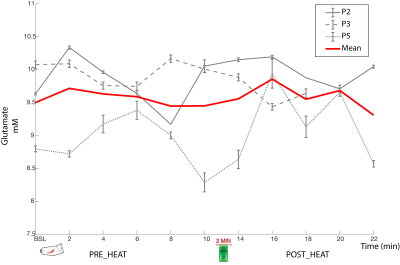 |
Tracking changes in glutamate using dynamic MRS in response to an acutely painful stimulus.
Jessica Archibald, Erin Macmillan, Carina Graf, Cornelia Laule, John Kramer
Current treatment and diagnosis of pain conditions are dependent on self-reported measures. The objective of this study was to establish the feasibility of determining changes in excitatory neurotransmitter concentrations (glutamate) in the anterior cingulate cortex (ACC) as an objective measure of pain using dynamic single voxel magnetic resonance spectroscopy (MRS). Glutamate levels can accurately be detected with this paradigm, although a general trend in relation to pain was not observed across subjects. This is the first study to report dynamic levels of glutamate in the ACC in relation to pain in healthy individuals using optimized MRS acquisition and processing methods.
|
|
1347.
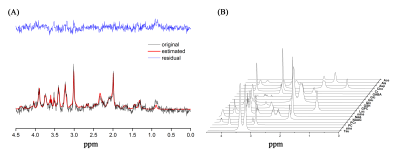 |
Hippocampal metabolite changes in response to chronic corticosterone exposure: in vivo magnetic resonance spectroscopy at 9.4T
Song-I Lim, Kyu-Ho Song, Chi-Hyeon Yoo, Hyeon-Man Baek, Bo-Young Choe
The purpose of the study is to investigate neurochemical changes in a mouse model using proton magnetic resonance spectroscopy. Animals received 1% of ethanol drinking water solution or 100μg/mL of corticosterone dissolved in 1% of ethanol drinking water for 4 weeks. MRS spectra were acquired at the end of the experiment. Mice that ingested corticosterone show elevated glutamate, glycerophosphocholine and taurine levels in the hippocampus compared with those shown by the control group. Increased corticosterone levels are considered a sign of stress or metabolic disturbance. Therefore we suggest that chronic corticosterone exposure can affect the hypothalamic-pituitary-adrenal dysregulation and neurochemical alteration.
|
|
1348.
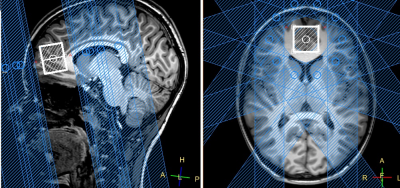 |
[Asp], [Glu] and [NAA] changes following traumatic brain injury revealed by J-edited 1H MRS.
Petr Menshchikov, Natalia Semenova, Andrei Manzhurtsev, Maxim Ublinskii, Ilya Melnikov, Tolib Akhadov
For the first time new method based on MEGA-PRESS pulse sequence for simultaneous aspartate (Asp), glutamate (Glu) and N acetyl aspartate (NAA) cerebral in vivo concentrations quantification were used for monitoring important metabolic changes after severe traumatic brain injury. Revealed Glutamate and Aspartate decrease is associated with excititoxicity (rapidly release of Glu and Asp from vesicles). In addition, Asp reduction might result from reduced availability of Glu.[NAA], marker of neuronal activity, reduction may be associated with synthesis disruption due to reduction of major NAA precussor (Asp).
|
|
1349.
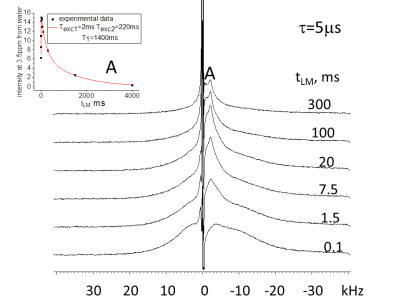 |
Magnetization transfer among non-aqueous species and between them and water in spinal cord
Uzi Eliav, Peter Basser, Gil Navon
Previous publications demonstrated that the intensity of white matter (WM) images of spinal cord stem from aqueous and non-aqueous protons (having a peak at 3.5ppm). The peak of the non-aqueous protons was analyzed to be a superimposition of signals with a distribution of T2* (10-1000μs). Questions unanswered by these studies are whether the peaks with short and long T2* exchange magnetization among themselves, and whether they transfer magnetization (MT) to water. In the present publication these questions are addressed by combining double quantum filtering with magnetization transfer. The results demonstrate exchange between non-aqueous species and between them and water.
|
|
1350.
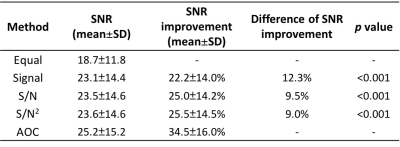 |
Multi-channel signal combination algorithms for polyunsaturated fatty acids (PUFA) using multiple quantum coherence (MQC) MRS in breast cancer
Vasiliki Mallikourti, Sai Man Cheung, Yazan Masannat, Ehab Husain, Steven Heys, Jiabao He
Polyunsaturated fatty acid (PUFA) is associated with malignant transformation of breast cancer and can be extracted from overwhelming background signals using multiple quantum coherence (MQC) MRS. Since MQC loses half of the signal, SNR enhancement through effective combination of signals acquired from multi channel coils holds significant potential. Investigations so far focused on conventional brain MRS, with drastically different metabolites and cluttered appearance compared to MQC MRS in breast. We therefore acquired PUFA spectra from 17 fresh breast tumour specimens and a patient on a clinical 3T scanner, and current algorithms of adaptively optimised combination (AOC), S/N2, S/N, Signal evaluated.
|
|
1351.
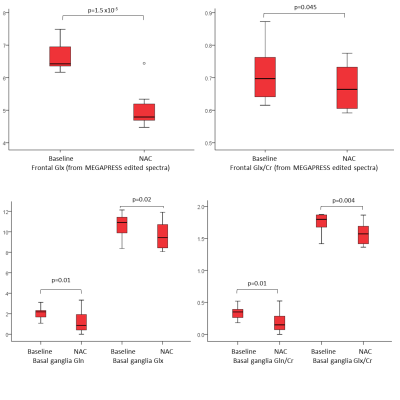 |
Detection of acute changes in glutamate with MR Spectroscopy using an N-acetylcysteine challenge
Ruth Tuura, Geoffrey Warnock, Alfred Buck, Valerie Treyer, Ralph Noeske, Michael Sommerauer
We examined acute changes in MRS-visible glutamate and glutamine after stimulation with N-acetylcysteine (NAC), since NAC reportedly decreases synaptic glutamate via activation of inhibitory metabotropic glutamate receptors. In 10 healthy adults, NAC significantly reduced Glx in the basal ganglia and prefrontal cortex. In the basal ganglia, the changes in Glx were driven by changes in Gln, suggesting that Gln might represent a proxy marker for synaptic glutamate. In the frontal lobe, the MEGAPRESS edited spectra showed greater sensitivity to changes in Glx than short TE PRESS or the edit OFF subspectra. Acute compartmental shifts in glutamate are detectable with MRS.
|
|
1352.
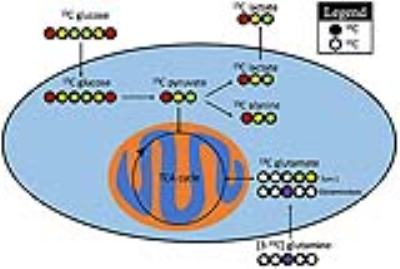 |
Characterizing altered glucose and glutamine metabolism in castration-resistant prostate cancer using high-resolution NMR
Jinny Sun, Renuka Sriram, Robert Bok, Romelyn Delos Santos, Mark Van Criekinge, Daniel Vigneron, John Kurhanewicz
This study demonstrates significant increases in flux through aerobic glycolysis, oxidative phosphorylation, and glutaminolysis with development of therapeutic resistance to androgen deprivation therapy using patient-derived cell lines and a transgenic murine model. Based on these metabolic differences between androgen-sensitive and insensitive prostate cancer, a combination of hyperpolarized [1-13C]pyruvate, [2-13C]pyruvate and [5-13C]glutamine can be used to noninvasively predict therapeutic resistance in future patient studies using HP 13C MRI.
|
|
1353.
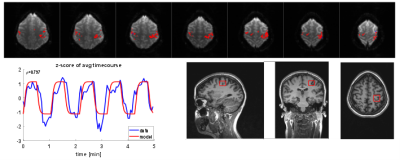 |
Increase in Glutamate concentration during motor activation measured using functional Magnetic Resonance Spectroscopy (fMRS) at 3T.
Osnat Volovyk, Assaf Tal
In the presented study we've demonstrated that small changes in Glutamate concentration associated with performing simple motor task can be reliably detected with 3T system using functional 1H MR spectroscopy. Comparison between two differently timed paradigms for motor activation revealed a clear preference for longer-block designs. This suggests that motor activity-induced changes in Glutamate concentration are of minutes-long time-scale.
|
|
1354.
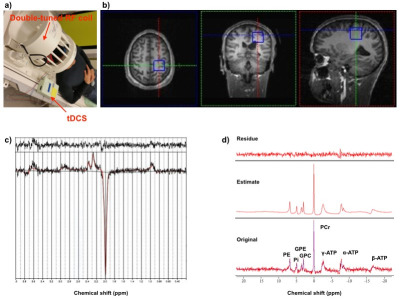 |
A 1H/31P MRS study of ATP and GABA modulation induced by anodal transcranial direct current stimulation in primary motor cortex of healthy subjects
Harshal Jayeshkumar Patel, Chang-Hoon Choi, N. Jon Shah, Ferdinand Binkofski
Transcranial direct current stimulation (tDCS) modulates cerebral energy and cortical inhibition. In this study we investigated long-term effects of anodal stimulation on inhibitory neurotransmitter and energy phosphate concentration using proton and phosphorous magnetic resonance spectroscopy. Our results indicate immediate GABA reduction following anodal tDCS and further maintaining the decreased state until the end of the experiment. ATP/Pi and PCr/Pi show initial reduction following anodal tDCS and further sign of recovery by the end of the experiment.
|
|
1355.
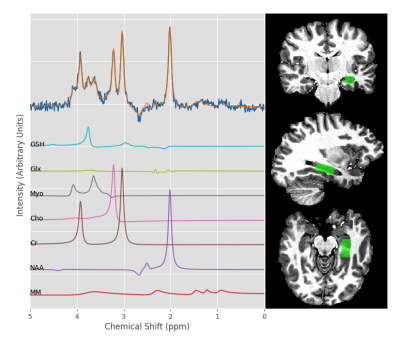 |
7T Magnetic Resonance Spectroscopy in the Hippocampus of MRI Normal Temporal Lobe Epilepsy Patients
John Adams, Simona Nikolova, Suzan Brown, Robert Bartha, Jorge Burneo
The utility of magnetic resonance spectroscopy for studying temporal lobe epilepsy (TLE) has been limited by magnetic field inhomogeneities. Using a 7T head-only MR system, we have successfully measured a number of metabolites which are challenging to measure in the hippocampus, including glutamate and glutathione, and we have observed a trend suggesting a decrease in creatine between contralateral and ipsilateral hippocampi in patients with unilateral, 1.5T MRI normal TLE.
|
|
1356.
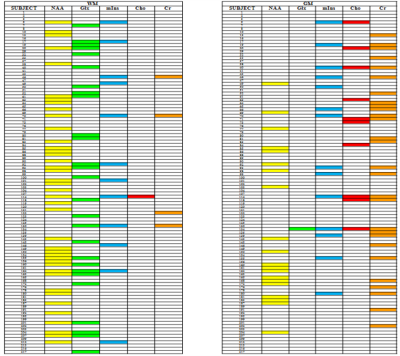 |
Exploring metabolite profiling of patients with secondary progressive multiple sclerosis
Anita Monteverdi, Bhavana Solanky, Floriana De Angelis, Domenico Plantone, Jonathan Stutters, Nevin John, Letizia Casiraghi, Ian Marshall, Sue Pavitt, Gavin Giovannoni, Christopher Weir, Nigel Stallard, Clive Hawkins, Basil Sharrack, Siddharthan Chandran, Jeremy Chataway, Claudia Gandini Wheeler-Kingshott
Proton magnetic resonance spectroscopic imaging (MRSI) quantifies brain metabolism in vivo and has the potential of uncovering the mechanism of action of therapeutic drugs. In this study, we assessed the baseline metabolic profile of 161 patients with secondary progressive multiple sclerosis (SPMS) against a control population by applying a short TE PRESS MRSI protocol at 3T. Based on the results the SPMS population could be divided into different groups (normal/biochemically abnormal) suggesting biochemical heterogeneity within SPMS patients.
|
|
1357.
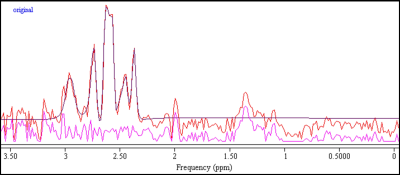 |
Anterior cingulate cortex glutathione decreases with age - faster in women than in men?
Adriana Anton, Catherine Gregory, Richard Smallman, Silke Conen, Faezeh Sanaei-nezhad, Bill Deakin, Steve Williams
The anti-oxidant glutathione (GSH) may protect against ageing. Significantly lower GSH in the occipital cortex has been reported in elderly compared to young healthy volunteers. Here we show that GSH is also decreased in middle-aged (N=8, 39-54y) compared to young (N=8, 22-32y) healthy subjects in the anterior cingulate but not the occipital cortex using GSH-edited MEGA-PRESS at 3T. This significant difference is driven by the women in the middle-age sub-group (significantly lower GSH than in men). This suggests that age-related oxidative stress begins earlier in women compared to men and sex composition of a studied group could influence results.
|
|
1358.
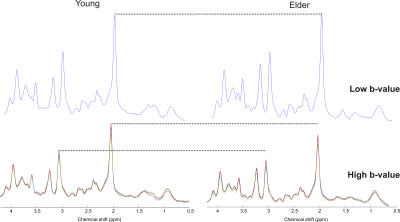 |
Higher apparent diffusion coefficients in the older human brain
Dinesh Deelchand, J. McCarten, Laura Hemmy, Edward Auerbach, Malgorzata Marjanska
The goal of this study was to compare the apparent diffusion coefficients (ADC) of the five major metabolites between young and older adults. Three brain regions were studied at 3 T using STEAM: prefrontal, posterior cingulate and occipital cortices. This study shows that the diffusivities of total N-acetyl aspartate, glutamate and myo-inositol are higher (7% on average) in the posterior cingulate cortex in older adults while no significant differences in ADC for the five major metabolites are observed in the other two brain regions studied. The ADCs of water are also higher in older adults in all three brain regions.
|
|
1359.
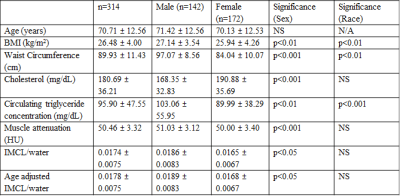 |
Contribution of Intramyocellular Lipids to the Decrease in Muscle Density with Age
Nicholas Brennan, Kenneth Fishbein, David Reiter, Richard Spencer, Luigi Ferrucci
Muscle density has been shown to decrease with age. However, the basis for this decrease remains unclear. We hypothesize that this decrease is associated with increased IMCL, and evaluated this relationship using localized 1H MRS of the vastus medialis muscle. We find that increased IMCL and decreased muscle density are strongly correlated across a large age range, even after controlling for multiple potential confounding variables.
|
|
1360.
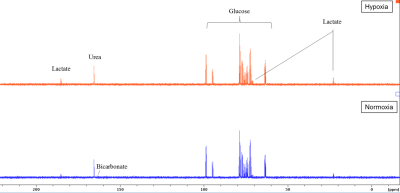 |
13C Magnetic Resonance Spectroscopy: Study of sperm metabolism under a hypoxic atmosphere.
Nurul Fadhlina Ismail, Steven Reynolds, Sarah Calvert, Martyn Paley, Allan Pacey
Studying energy metabolism in sperm may be helpful in understanding the relationship between motility and infertility. To understand sperm metabolism, we acquired 13C MR spectra during incubation with 13C-glucose in a normal and hypoxic atmosphere. Studies suggested that glycolysis is the main pathway for energy metabolism in sperm but whether glycolysis or oxidative phosphorylation(OXPHOS) dominates varies among species. This study examined the effect of hypoxia on sperm energy metabolism, with a secondary aim to observe Krebs cycle intermediates in the MR spectrum. Lactate signal in the hypoxia group was significantly higher than in the normoxia group. No Krebs cycle intermediate was detected.
|
|
MRS Animal Studies
Traditional Poster
Spectroscopy & Non-Proton MR
Monday, 18 June 2018
| Exhibition Hall 1361-1368 |
08:15 - 10:15 |
|
1361.
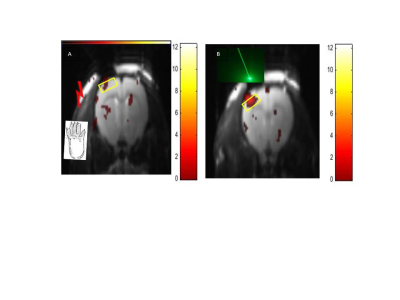 |
Opto-functional Magnetic Resonance Spectroscopy (O-fMRS): investigating brain energetics under optogenetic and sensory stimulation
Nathalie Just, Cornelius Faber
For a better understanding of metabolic processes underlying neurovascular mechanisms, fMRS represents a suitable technique. The combination of fMRS and optogenetics (O-fMRS) should allow targeting the metabolism of specific cell populations during their activation. Our study aims at developing O-fMRS methodology in rat to provide further insight into brain energetics during activation. Here we establish a comparison between O-fMRS and sensory-fMRS in the rat forepaw cortex to investigate whether energetic demands are similar.
|
|
1362.
 |
Comparison of in vivo MRS and ex vivo HR-MAS MRS for assessment of metabolite content in the GOT1 small intestine neuroendocrine tumour model
Mikael Montelius, Johan Spetz, Diana Bernin, Oscar Jalnefjord, Maria Ljungberg, Eva Forssell-Aronsson
In vivo characterisation of tumour metabolism using MRS would facilitate tumour therapy response assessment, but in vivo conditions may obscure the metabolic information acquired. In this study we investigate the information contained in in vivo MRS spectra of a neuroendocrine tumour model by correlating it to ex vivo HR-MAS MRS on excised tumour samples. Effects of post-mortem tissue degradation and tumour sample site on in vivo–ex vivo correlations are evaluated, and interpretation of in vivo data is discussed.
|
|
1363.
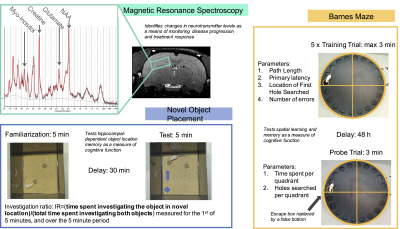 |
A neuroimaging study of the effects of early vs. late anti-inflammatory treatment in a rodent model of Alzheimer’s disease
Caitlin Fowler, Dan Madularu, John Breitner, Jamie Near
Alzheimer’s disease (AD) is a progressive neurodegenerative disorder with no effective treatments or known biomarkers for definitive diagnosis, substantiating the need for early detection of AD and early intervention. This project employs Magnetic Resonance Spectroscopy (MRS) to measure changes in neurometabolites as compared to behavioural measures of cognitive function, in a transgenic rat model of AD under treatment conditions. Preliminary results suggest that changes in metabolite levels are present before the onset of cognitive impairment, and between treatment and control groups, with some of these changes being sexually dimorphic.
|
|
1364.
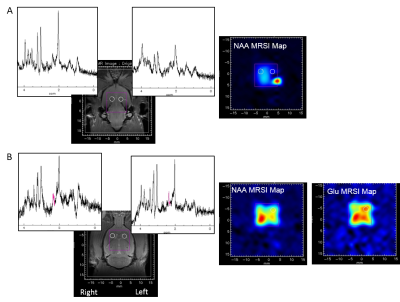 |
Longitudinal follow-up of brain metabolism in rat models of progressive Parkinson's disease using Magnetic Resonance Spectroscopy Imaging.
Carine Chassain, Christophe Melon, Guilhem Pages, Yann Le Fur, Pascal Salin, Lydia Kerkerian-Le Goff, Franck Durif
The development of animal models that reproduce the selective and progressive loss of nigral dopamine neurons characterizing Parkinson’s disease has opened new possibilities to study the disease evolution. Here magnetic resonance spectroscopy imaging was used to follow up the distributions of metabolites in key basal ganglia components in two rat models of progressive parkinsonism at three time points over a period of 120 days following injury. First results on overtime changes in NAA and glutamate repartition will be presented. Completion of this project may provide novel insights onto the pathological alterations associated with the progression of the neurodegenerative process.
|
|
1365.
 |
Metabolic Consequences in the Heart and Skeletal Muscle of Human Pancreatic Cancer Xenograft Growth
Santosh Bharti, Paul Winnard Jr., Yelena Mironchik, Marie-France Penet, Zaver Bhujwalla
To understand the metabolic events that occur during cancer-induced cachexia, here we analyzed the effects of human pancreatic cancer xenografts on heart and skeletal muscle metabolites using 1 H MRS. Studies were performed with cachexia-inducing Pa04C and non-cachexia inducing Panc1 human pancreatic cancer xenografts, since cachexia occurs most frequently in pancreatic cancer. 1H MR spectra identified differences in heart and skeletal muscle metabolites of cachectic and non-cachectic mice, as well as between normal mice and cachectic as well as non-cachectic mice. Our data highlight the systemic metabolic changes that occur with tumor growth and provide new insights in cancer-induced cachexia.
|
|
1366.
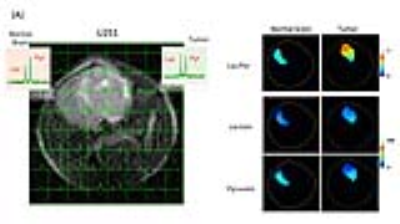 |
Metabolic imaging of glioblastoma using hyperpolarized 13C-MRI - glycolytic metabolism in cancer stem cell-like cells.
Tatsuya Kawai, Jeffery Brender, Kevin Camphausen, Murali Krishna
Dynamic nuclear polarization-MRI along with hyperpolarized [1-13C] pyruvate was conducted to evaluate the difference in glycolytic profile between a glioblastoma cell line and cancer stem-like cells using the orthotopic xenograft mouse model.
|
|
1367.
 |
Does maternal swimming during gestation protects the neonatal brain from hypoxic-ischemic injury?
Yohan van de Looij, Eduardo Sanchez, Petra Hüppi, Stéphane Sizonenko
There are growing evidences that swimming during gestation has a neuroprotective effect on offspring perinatal brain injuries. The aim of this work was to assess this neuroprotective effect on P3 hypoxic-ischemic model by 1H-MRS and diffusion MRI (DTI and NODDI) at 9.4T. A moderate, but real effect of swimming during gestation on the neurochemical profile 24h after HI was observed. Difference in neurochemical profile between sedentary and swimming rats may lead to a different response to the injury. At long-term, diffusion MRI derived parameters changes following HI were restored in the swimming HI group, providing evidence of a neuroprotective effect.
|
|
1368.
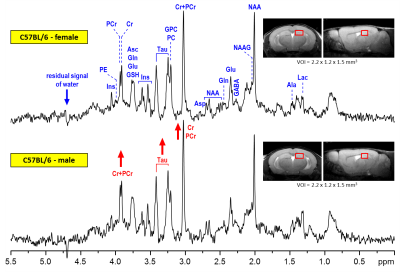 |
Differences between neurochemical profiles of male and female C57BL/6 mice
Sarah Larson, Ivan Tkac
The purpose of this study was to demonstrate whether neurochemical profiles of male and female C57BL/6 mice were affected in a sex-related manner. In vivo 1H MRS data were acquired from four different groups of mice, each group consisting of 10 male and 10 female mice. Highly significant differences between male and female groups were consistently observed in each group. These results have serious implications for appropriate quantification referencing (water vs. creatine, male or females in treated vs. control group) for avoiding bias in data interpretation.
|
|
| Back |
| The International Society for Magnetic Resonance in Medicine is accredited by the Accreditation Council for Continuing Medical Education to provide continuing medical education for physicians. |


































































































